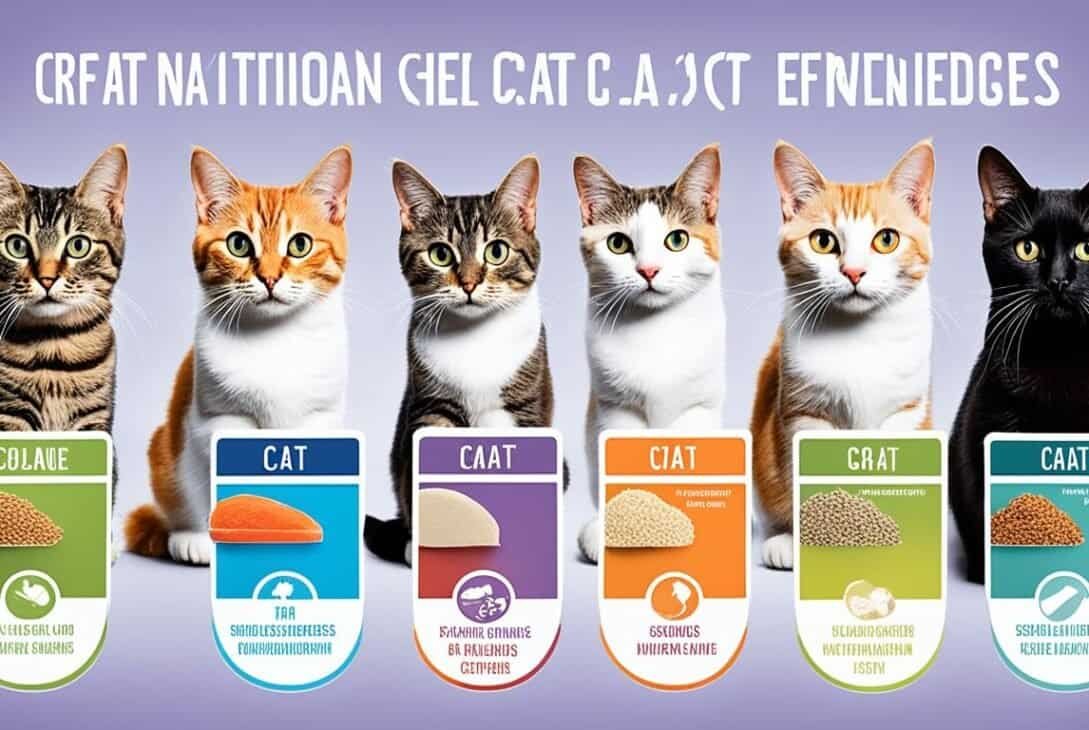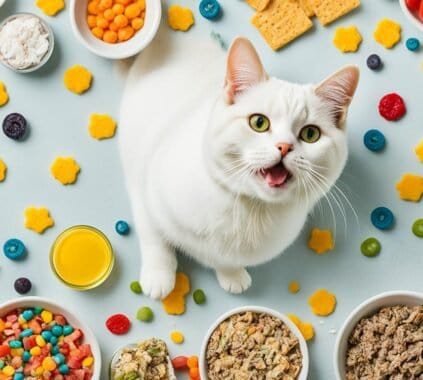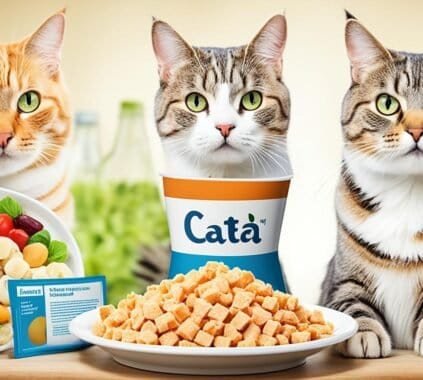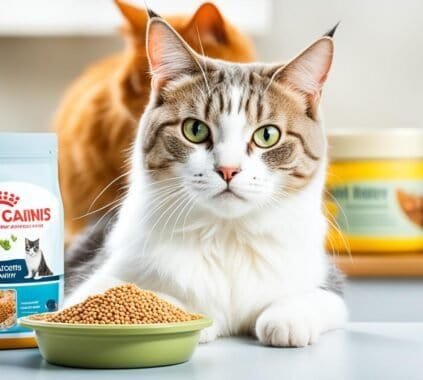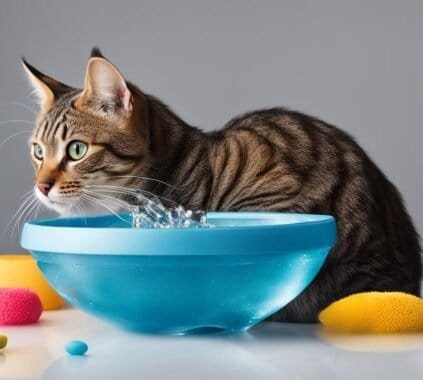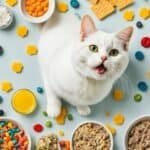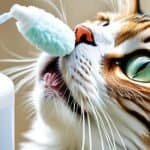Welcome to our comprehensive guide on cat nutritional needs by age. Understanding your cat’s dietary requirements is crucial for ensuring their overall health and well-being. Cats are obligate carnivores and have unique nutritional needs that vary throughout their lives.
Proper nutrition plays a vital role in every stage of a cat’s life, from kittenhood to adulthood and into their senior years. Their diet should be tailored according to their age, lifestyle, body condition, breed size, and reproductive status.
Choosing the right cat food is essential to provide your feline companion with the necessary nutrients to thrive. Whether you opt for wet food, dry food, or a combination of both, it is important to understand the benefits each option offers.
In this feline nutrition guide, we will take an in-depth look at the nutritional needs of cats at different stages of life and provide valuable insights to help you make informed decisions regarding your cat’s diet.
Key Takeaways:
- Cats are obligate carnivores and require a diet that consists of at least 70% animal meat.
- Kittens, adult cats, and senior cats have different nutritional needs and should be fed accordingly.
- Choosing the right cat food based on your cat’s life stage, lifestyle, body condition, breed size, and reproductive status is crucial.
- Feeding guidelines should be followed to ensure your cat receives the right amount of calories and nutrients.
- Consulting a veterinarian for a detailed cat feeding guide and making necessary dietary adjustments based on your cat’s individual needs is highly recommended.
Making a Feeding Plan for Your Cat
Creating a well-structured feeding plan is essential to ensure your cat’s nutritional needs are met. A strategic cat feeding schedule helps maintain a healthy weight, promotes digestion, and establishes a routine. When designing a feeding plan for your furry friend, consider their nutritional and individual needs.
It is recommended to divide your cat’s daily diet into two main meals or multiple smaller meals throughout the day. These meals should be spaced no more than 12 hours apart, providing your cat with sufficient calories and nutrients to support their overall health and well-being.
Just like humans, cats can exhibit various feeding habits. Some cats may play with their food or hoard it, which are typically normal behaviors. However, it is important to monitor your cat’s eating habits closely. If your cat consistently leaves behind a significant amount of food, experiences sudden weight gain, or goes more than 24 hours without eating, it may be a cause for concern and warrant veterinary attention.
By observing your cat’s feeding habits and adjusting their feeding plan accordingly, you can ensure they receive the appropriate amount of food and maintain a healthy lifestyle.
Choosing the Right Food for Your Cat
When it comes to selecting the best food for your cat, there are several factors to consider. The cat’s life stage, lifestyle, body condition, breed size, and reproductive status play a crucial role in determining their nutritional needs. By understanding these factors and making informed choices, you can ensure that your cat receives a balanced and nutritious diet.
Life Stage
Cats go through different life stages, each with its specific nutritional requirements. Kittens, for example, need a higher calorie intake to support their growth and development. Their food should contain essential nutrients like protein, vitamins, and minerals to meet their growing needs. As they transition into adulthood, around 10 months of age, they can be switched to adult cat food that is specially formulated to support their maintenance needs. Senior cats, on the other hand, may have reduced metabolic rates and may require fewer calories. An age-appropriate diet is essential for each life stage to ensure optimal health.
Lifestyle and Body Condition
The lifestyle of your cat also impacts the selection of their food. If your cat has an active lifestyle, they may require a higher calorie intake to fuel their energy needs. Conversely, if your cat has a more sedentary lifestyle, they may need a lower-calorie food to avoid unnecessary weight gain. It’s important to assess your cat’s body condition regularly and consult with your veterinarian to determine the appropriate food for maintaining a healthy weight.
Breed Size and Reproductive Status
Cat breeds come in various sizes, and their nutritional needs can vary. Smaller breeds may require a different balance of nutrients compared to larger breeds. Additionally, a cat’s reproductive status can also influence their dietary needs. Pregnant and nursing cats, for example, need additional calories and nutrients to support their own health and the development of their offspring. If your cat has specific health conditions or is pregnant, consulting with a veterinarian for a specialized diet recommendation is essential.
Choosing the right cat food based on these factors is crucial for maintaining your cat’s overall health and well-being. By selecting a food that aligns with their life stage, lifestyle, body condition, breed size, and reproductive status, you can provide them with the essential nutrients they need. Consult with your veterinarian for a detailed cat feeding guide and to make any necessary adjustments to your cat’s diet.
Feeding Frequency and Portion Control
The feeding frequency and portion size are important factors when it comes to maintaining the health of your cat. The appropriate feeding frequency and portion size depend on various factors such as their age, size, and activity level.
- Kittens: Kittens should be fed three times a day until they reach four months of age. This is because they have higher energy requirements for proper growth and development.
- Adult Cats: Once kittens reach four months of age, their feeding frequency can be reduced to twice a day. Most adult cats do well with two meals a day, ensuring they receive a balanced diet.
- Feeding Guidelines: Cat food packages typically provide feeding guidelines that recommend the appropriate portion size based on the cat’s age, size, and activity level. These guidelines are a helpful starting point, but it’s important to monitor your cat’s body condition and adjust the portion size as needed.
- IAMS Cat Food: IAMS offers a range of cat food options that cater to different life stages and activity levels. They provide recommended portion sizes to help you ensure your cat receives the appropriate amount of nutrition. Be sure to consult the feeding guidelines on the IAMS cat food package and consult your veterinarian for any specific dietary recommendations.
It’s worth noting that while feeding frequency and portion control are important, it’s equally important to monitor your cat’s overall health and body condition. Obesity is a common health issue in cats, so it’s essential to strike the right balance between providing enough food and preventing overfeeding. Regular check-ups with the veterinarian can help you stay on top of your cat’s nutritional needs.
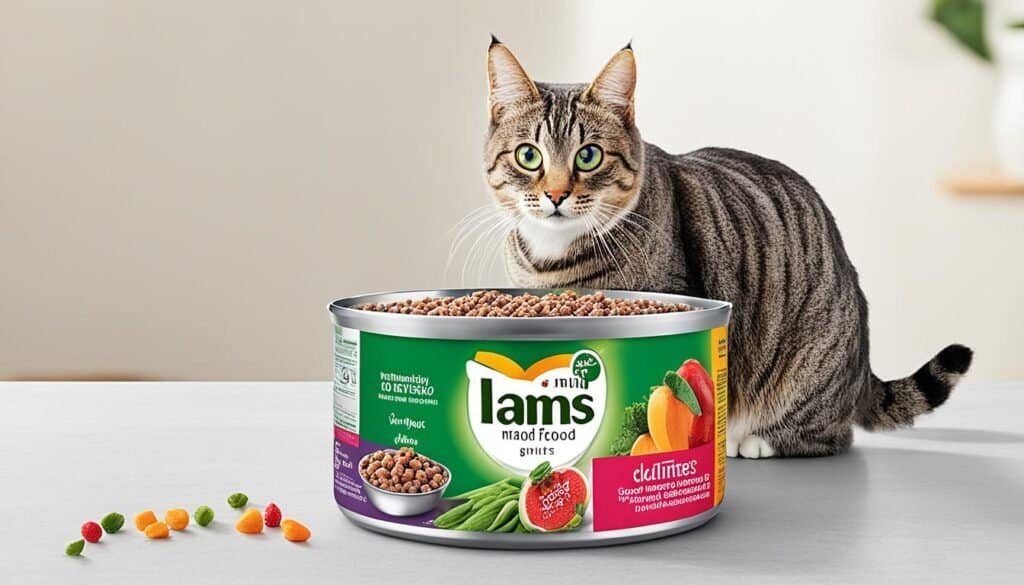
Wet Food vs. Dry Food
When it comes to choosing cat food, both wet and dry options have their own unique benefits. Understanding the advantages of each can help you make the best decision for your feline friend’s nutritional needs.
Wet food for cats is an excellent choice for a few reasons. Firstly, it helps ensure that your cat stays hydrated since it has a high moisture content. This is especially beneficial for cats that don’t drink enough water, as it can contribute to urinary health. Additionally, wet cat food comes in a wide variety of flavors, allowing you to provide your cat with a range of tastes to satisfy their palate. Wet food is also high in protein, which supports strong muscles. It also helps maintain that muscle mass through adulthood and into a cat’s senior years.
On the other hand, dry food for cats has its own advantages. Dry food is convenient, as it can be left out for grazing throughout the day without spoiling. It is also beneficial for dental health, as the crunchy texture can help remove plaque and tartar, promoting healthier teeth and gums. Dry food also has a longer shelf life compared to wet food, making it more convenient to store.
While it’s not necessary to feed both wet and dry food, a combination of the two can provide a well-rounded and balanced diet for your cat. The wet food ensures hydration and variety, while the dry food offers convenience and dental health benefits. It’s important to choose high-quality cat food that meets the specific cat nutritional needs of your cat, considering their age, breed, and any existing health conditions.
Consulting with a veterinarian can provide valuable guidance on the best food options for your cat. They can recommend specific brands or formulas that align with your cat’s unique needs, ensuring they receive all the essential nutrients for optimal health.
Overall, the choice between wet food and dry food depends on your cat’s preferences, health considerations, and lifestyle. By selecting the right food and feeding regimen, you can provide your cat with a nutritious and satisfying diet.
The Benefits of Wet Food for Cats:
- Ensures cats stay hydrated
- Supports urinary health
- Available in various flavors
The Benefits of Dry Food for Cats:
- Convenient and can be left out for grazing
- Promotes dental health by reducing plaque and tartar
- Has a longer shelf life
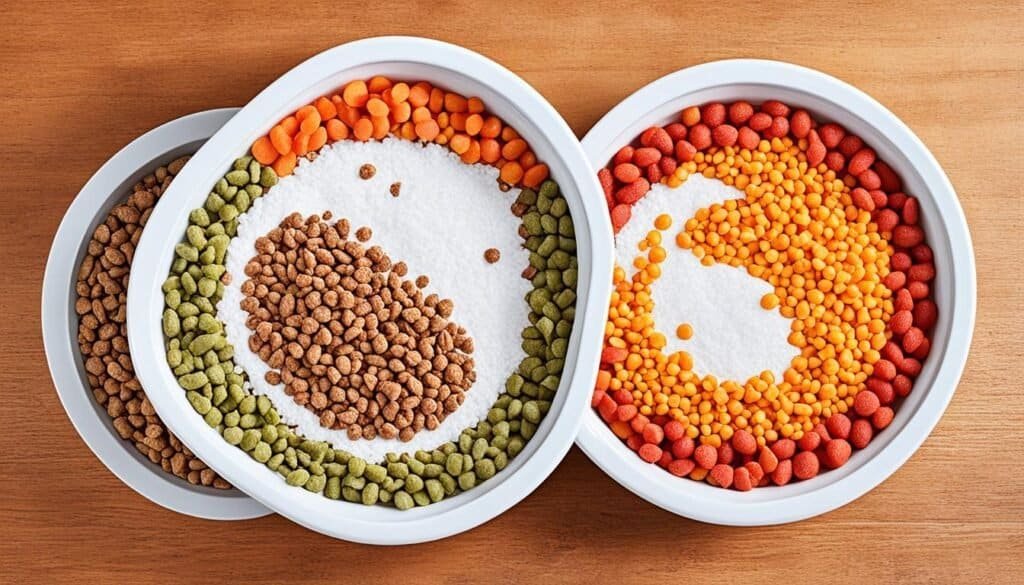
Conclusion
Meeting the nutritional needs of cats at different life stages is crucial for their overall health and well-being. Cats require specific nutrients at each age, and their diet should be tailored accordingly. A balanced diet that provides the right amount of calories and nutrients is essential for optimal cat health.
Choosing the right cat food is a key factor in meeting their nutritional needs. By selecting high-quality cat food that is appropriate for their age, size, and specific health conditions, cat owners can ensure that their furry companions receive the necessary nutrients to thrive. Following feeding guidelines provided by veterinarians and pet food manufacturers can aid in providing cats with a well-rounded diet.
Consulting a veterinarian is highly recommended to ensure that cats are on the right track to optimal health. Veterinarians can provide customized feeding plans, recommend age-specific cat diets, and offer advice on any adjustments or dietary supplements that may be needed. By understanding and meeting the nutritional needs of their feline companions, cat owners can contribute to their long and healthy life.
FAQ
What are the cat nutritional needs by age?
How do I create a feeding plan for my cat?
How do I choose the right food for my cat?
How often should I feed my cat and how much should I feed them?
Should I feed my cat wet food or dry food?
Last modified: February 25, 2024

